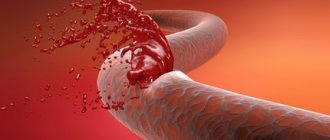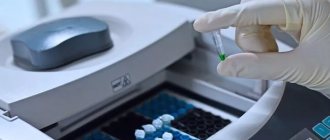The text is presented for informational purposes only. We strongly urge you not to self-medicate. When the first symptoms appear, consult a doctor. We recommend reading: “Why you can’t self-medicate?”
Steatorrhea is a condition in which at least 7 g of neutral fat is excreted in the stool. This happens due to impaired digestion and/or absorption of fats in the body. Steatorrhea occurs regardless of age and gender, and can be either an independent disease or a symptom of another pathology.
Creatorrhea and amilorrhea are often detected together with steatorrhea.
Medical products (drugs, medicines, vitamins, dietary supplements) are mentioned for informational purposes only. We strongly do not recommend using them without a doctor's prescription. We recommend reading: “Why can’t you take medications without a doctor’s prescription?”
Classification
According to the development mechanism
- Pancreatic. Pancreatic cells produce pancreatic lipase, the main enzyme that breaks down fats. With pathology of the gland, the production of lipase decreases, and neutral fat supplied with food begins to be excreted in the feces. This type of steatorrhea is considered the most common, so it has a separate code in the International Classification of Diseases.
- Cholecystohepatic. A decrease in the production of bile by liver cells, a change in its composition, and difficulty in entering the duodenum leads to a deterioration in the absorption of fats and the development of steatorrhea.
- Intestinal (enterogenous). With the help of bile and pancreatic lipase, fats are broken down into glycerol and fatty acids, which are absorbed into the blood through the villi of the small intestine. With intestinal pathology, this process is disrupted.
- Nutritional. Steatorrhea occurs due to excessive consumption of fatty foods, when the intake of fat exceeds the functionality of the pancreas.
By origin
- primary – steatorrhea is an independent disease and develops as a result of congenital changes in the pancreas;
- secondary – occurs against the background of another pathology.
Laboratory types of steatorrhea
- type I – predominantly neutral fat is detected in the stool;
- type II – fatty acids and soaps predominate in the stool;
- mixed - neutral fat, soap and fatty acids are present in different proportions.
Interesting and useful
13.02.2019
Steatorrhea
There are situations when a patient, after undergoing laboratory tests to identify the cause of intestinal dysfunction, accompanied by quite severe symptoms, hears a mysterious word - steatorrhea.
Few people know the danger such a diagnosis poses. Popularly it is otherwise called fatty diarrhea. There are 3 types of disease: • Neutral fats are present in the stool, the main component of animals or plants; • Human feces contain soaps and compounds of oxygen, hydrogen and carbon that can react with alkalis; • Stools contain evidence of both types. The most dangerous form of this pathology is most often observed with blockage of the Wirsung duct or diseases of the pancreas and is called pancreatic. When this pathology develops, the patient's stool has a greasy sheen, a grayish-clay tint, and comes out in the form of loose stool. In the rarest cases, the disease occurs with constipation. Causes of steatorrhea Pancreatic steatorrhea can occur due to the fact that fat absorption in the intestine is impaired. If in a healthy body their excretion in feces is no more than 5 grams per day, then with the development of this disease an excess amount of sebaceous masses appears in the feces. The disease in adults can also be provoked by the abuse of laxatives, due to which rapid excretion of feces occurs, chronic pancreatitis that develops against the background of alcoholism, and other pathologies inherent in the liver, pancreas and small intestine. In addition, the causes of steatorrhea can be the following: • Fatty diarrhea appears due to systemic manifestations of skin diseases that, in addition to the skin, also affect internal organs. According to statistics, this type of diarrhea is most often caused by eczema or psoriasis; • Pathologies of endocrine organs or endocrine glands (Addison's disease, hyperthyroidism); • Congenital or hereditary diseases in which the absorption and transfer of fats is impaired. In addition to these pathological factors, type 1 disease can also be provoked by infections or inappropriate diets, which cause disturbances in the functional activity of the gastrointestinal tract. In this case, fatty, loose stools in an adult are short-lived. To stop this type of diarrhea, it is enough to adjust your diet or get rid of the infection that caused steatorrhea. However, even if its occurrence is provoked by these factors, but it lasts more than a few weeks, or is accompanied by other manifestations and causes concern, it is necessary to seek medical help. If the patient ignores timely and adequate treatment, steatorrhea can cause quite severe complications that arise due to the fact that nutrient absorption in the intestine is impaired: • Convulsive conditions and dehydration caused by a violation of the water-salt balance, the reason for the development of which is frequent loose stools; • Protein deficiency. It occurs due to the fact that due to steatorrhea, the body does not receive enough proteins. Also, a deficiency of fat-soluble vitamins caused by pathology causes hypovitaminosis; • With this disease, both adult patients and children experience profound exhaustion of the body (cachexia) and weakness. This complication occurs due to the patient's weight loss. Steatorrhea also affects the brain, respiratory system, heart and kidneys. Problems of a psychological nature may also arise, due to which sleep is disturbed, the quality of work decreases, and communication becomes difficult. Symptoms of steatorrhea When fatty diarrhea occurs in an adult, patients usually complain of large, frequent and loose stools, which causes symptoms of dehydration (constant thirst, dry skin and mucous membranes). In addition, patients are worried about transfusions and rumbling in the abdomen, bloating of the upper intestine, dizziness, decreased performance, lethargy and general malaise. Since this pathology affects people of different age groups, you should also know the signs that accompany it in the youngest patients. Steatorrhea in children is characterized by the following symptoms: • Externally, feces look like greasy diarrhea and have an oily sheen; • When the potty is washed after a child has defecated, indelible greasy stains remain on it. Steatorrhea in infants occurs due to genetic disorders or poor liver function. Also, in young patients, the occurrence of greasy diarrhea is strongly influenced by any gastrointestinal disease. In newborn babies, fatty, loose stools can also be caused by a lack of enzymes. Treatment of steatorrhea Very often, patients ask the question what to do when fatty diarrhea occurs and how to treat steatorrhea. Due to the fact that greasy stools of any type are not a disease itself, but only a symptom of the disease that provoked them, you should get rid of the disease that caused this unpleasant symptom directly. For a pathology such as steatorrhea, treatment should be conservative. This is especially true for its pancreatic form. Therapy is based on the following principles: • It is necessary to eliminate the manifestations of exacerbation; • Correct functional pancreatic insufficiency; • Carry out maintenance therapy and prevention with folk remedies. Treatment of steatorrhea with folk remedies has long been approved by specialists and allows one to quickly and without negative consequences relieve symptoms characteristic of this pathology, such as pain, indigestion, and greasy stool. This is possible because all the drugs used in this type of therapy are prepared on the basis of medicinal herbs and, while highly effective, do not cause addiction in the patient. Steatorrhea during pregnancy In women carrying a child, pathology most often occurs in the later stages. It can be provoked by cholestasis, which is characterized by a violation of the outflow of bile due to the fact that the increasing size of the uterus compresses the gallbladder. Symptoms of the disease in pregnant women are that during diarrhea, discolored and foul-smelling feces are released, and the mucous membranes turn yellow. Among the complications of steatorrhea, which occur only in pregnant women due to a malabsorption of vitamins, the following can be mentioned: • Reduced blood clotting, which can lead to bleeding during childbirth; • Disturbances in the development of fetal bones; • Deterioration of vision and skin in the mother and fetus. It is possible to completely get rid of steatorrhea during pregnancy only with the use of a complex method of therapy, which, in addition to the use of medications, involves the use of folk remedies and adherence to an appropriate diet. There are also general recommendations. These include avoiding fried, spicy and fatty foods, as well as alcohol and additional intake of vitamins K, E, D and A. Diagnosis The search for the causes of steatorrhea begins with a detailed examination, including the doctor’s clarification of the patient’s dietary habits and lifestyle. The doctor will need the results of tests of feces, urine, blood and instrumental diagnostics (MRI, ultrasound, fluoroscopy, rectoscopy, radioisotope studies, etc.). With a long course of the disease, additional diagnostic measures are required, the purpose of which is to identify and evaluate possible complications that often occur with disorders of fat metabolism. Possible complications
Impaired absorption capacity of the intestine leads to the following conditions:
- Protein deficiency.
- Imbalance of electrolytes, resulting in cramps, dry mucous membranes, swelling, and incessant thirst.
- Oxaluria in the form of insoluble stones consisting of oxalates and capable of clogging the urinary tract and kidneys.
- Pathologies of the brain, respiratory system, heart and kidneys.
- Neuroses in which the patient has mental problems, for example, difficulty communicating, decreased performance, sleep disturbances.
Treatment must be timely, using the correct therapeutic approach. It is not steatorrhea that is treated, but the underlying provoking disease.
The doctor prescribes medications containing lipase. They are covered with a shell that protects them from stomach enzymes.
Antacids are prescribed to neutralize hydrochloric acid:
With them, enzyme therapy is much more effective.
Prescription of Cortisone, hydrochloric acid and adrenocorticotropic hormone with parallel control of ketosteroids, which are supported by protein intake.
Diet therapy
The doctor recommends split meals with 4-6 meals and portions weighing no more than 200 g.
The nutritionist creates prescriptions on an individual basis, taking into account the causes of the condition, the severity of the underlying pathology, and additional symptoms.
Among the general recommendations:
· exclusion of spicy, fried and fatty foods;
· refusal of alcohol;
· Drinking plain water instead of sweet soda.
The following animal proteins are allowed:
· lean varieties of fish and meat that are best boiled;
· low-fat fermented milk products instead of whole milk.
Mandatory vitamin therapy with the prescription of vitamins B5 and B12, as well as fat-soluble vitamins K, E, D and A.
Prevention
To avoid the development of steatorrhea, you should:
- Enrich your diet with animal proteins instead of soybeans and other legumes.
- Eliminate foods containing gluten from your diet.
- Bring sugar intake to moderate doses.
Secondary prevention, which is carried out after the development of a pathological condition, involves timely therapy to get rid of the underlying disease, for example, intestinal infections using antibacterial agents.
The disease will not occur if you prevent diseases that provoke steatorrhea, organize a balanced diet with a moderate amount of fatty foods, with plenty of proteins and vitamins. With timely treatment, the disease goes into stable remission and practically does not bother the person.
Conclusion
Fatty stool with a constant urge to defecate is not the norm. To avoid life-threatening consequences, you should promptly pay attention to this symptom and take action.
Causes
- congenital and acquired diseases of the pancreas: chronic pancreatitis, tumors and cysts, cystic fibrosis;
- diseases of the liver and biliary tract: cholelithiasis, chronic cholecystitis, gallbladder dysfunction, chronic hepatitis, cirrhosis of the liver, tumors of the liver and bile ducts;
- intestinal diseases: chronic enteritis, colitis, tumors;
- history of surgical treatment of the gastrointestinal tract: condition after cholecystectomy (removal of the gallbladder), resection of the intestine or stomach (removal of part of the organ);
- alcohol abuse – leads to the development of alcoholic hepatitis, pancreatitis, and then steatorrhea;
- previous infectious intestinal diseases: dysentery, salmonellosis;
- helminthic infestations, giardiasis;
- addiction to fatty foods;
- abuse of laxatives and weight loss drugs;
- heredity - a genetically determined defect in pancreatic lipase, a predisposition to autoimmune diseases.
2. Causes of steatopancreatitis
Potentially dangerous factors that threaten pancreatic lipomatosis are conventionally divided into two groups: toxic and metabolic.
Toxic exposure, especially long-term, leads to the destruction of healthy pancreatic cells. To preserve the volume and maintain the geometry of the organ, a mechanism is activated to replace them with adipose tissue. The growth of fatty layers in the thickness of cells capable of functioning normally affects the activity of the entire organ, which gradually loses its functional viability.
The most common factors of toxic effects on the pancreas:
- long-term nicotine intoxication;
- systematic use of alcohol;
- taking certain medications that strain the pancreas.
Metabolic factors for the most part can be controlled and adjusted. These are excess weight, diet, food intake, nutritional balance, physical activity. The category of metabolic factors beyond human control includes chronic diseases of the gastrointestinal tract and liver, and diabetes mellitus. Steatopancreatitis can develop secondary to their background.
Recently, fasting and extreme diets have also been identified as risk factors. Sharp changes in the volume of incoming food stimulate the processes of fat accumulation in organs and tissues when conditions favorable for this occur.
Some types of medical care can also precipitate steatosis (eg, intravenous nutrition), but in most cases where intravenous nutrition is prescribed, there is no alternative.
Visit our Gastroenterology page
Symptoms
Signs of the disease develop gradually. At first, the state of health worsens after errors in the diet (eating fatty foods), then the complaints become constant.
- Change in stool character. The feces acquire a grayish tint and shine, and a whitish film-like coating appears on the surface. Their consistency becomes ointment-like or mushy, with lumps of undigested food. A typical sign is hard-to-wash marks on the walls of the toilet.
- Frequency of bowel movements up to 3-6 times a day.
- Stitching or cramping pain in the abdomen of uncertain localization.
- Bloating and rumbling in the stomach are signs of increased gas formation and an increase in the amount of intestinal contents.
- Loss of body weight. When pancreatic function is impaired, the production of not only lipase, but also enzymes that break down carbohydrates and proteins, decreases. The body does not receive vital substances, so a person loses weight, children experience growth retardation
- Signs of deficiency of microelements and fat-soluble vitamins. Lack of vitamin K leads to increased bleeding, vitamin E to muscle weakness, vitamin A to vision impairment, vitamin D to the development of rickets in children and osteoporosis in adults. Impaired iron absorption leads to anemia.
1.What is steatopancreatitis
Steatopancreatitis is a disease caused by fat cells replacing pancreatic tissue. This pathology belongs to the gastroenterological profile, but is one of the few diseases associated largely with a person’s lifestyle. Unlike diseases caused by heredity, infections and other inevitable factors, pancreatic steatosis can be avoided if you give up bad habits, overeating, a sedentary lifestyle and a fat-containing diet.
The insidiousness of steatopancreatitis is that it can be asymptomatic for a long time, and ultimately lead to a sudden exacerbation - pancreatic dysfunction.
The group at greatest risk for steatopancreatitis are men in adulthood and old age, since by this time many of them had been using nicotine and alcohol for a long time, had errors in their diet, and overeated. The effect of pancreatogenic factors in women is lower, however, after 60 years, the risk of developing steatosis also increases.
A must read! Help with treatment and hospitalization!
Diagnostics
Diagnosis and treatment of steatorrhea is carried out by a gastroenterologist.
- Anamnesis collection. The doctor clarifies the complaints, the conditions under which they appear, and determines the duration of the disease.
- Inspection. The doctor assesses the body mass index, pays attention to the nature of the skin and visible mucous membranes, then palpates the abdomen, detects pain and fluid transfusion.
- General blood analysis. Anemia is possible, in severe cases leukocytosis and increased ESR.
- Blood chemistry. A change in certain indicators indicates an underlying disease. An increase in the level of ALT and AST indicates liver pathology, an increase in the level of direct bilirubin indicates a violation of the outflow of bile. With severe pathology of the pancreas, blood glucose levels may increase.
- Coprogram. Microscopic examination of stool reveals drops of neutral fat, soap and fatty acids, undigested muscle fibers and starch grains.
- Quantitative determination of fat in three-day feces. The patient eats at least 100 g of fat every day for three days and collects feces in a separate container. Detection of more than 15 g of fat indicates steatorrhea. The method is difficult to implement, so it is used quite rarely.
- Acid steatocrit method. A stool sample is centrifuged, followed by determination of the lipid component.
- Study of pancreatic juice. Using a probe, pancreatic secretion is obtained from the duodenum and the amount of main enzymes in it is determined.
- Radioisotope methods. The patient is injected with labeled isotopes and their content in the blood, feces, and urine is determined at fixed intervals. Using radioisotopes, the type of steatorrhea is determined.
- Ultrasound of the abdominal organs. The method allows you to evaluate the size and structure of the pancreas, gall bladder, and liver.
- CT scan. Compared to ultrasound, this is a more sensitive method that helps clarify the nature of changes in internal organs.
- ERCP. A method for examining the condition of the bile ducts and pancreatic duct using an endoscope and a radiopaque agent.
3. Symptoms of pancreatic steatosis and diagnosis
Signs of the onset of the steatopancreatic process can be very blurred and be expressed by irregular disorders of the digestive process. At some point, for no apparent reason, a person experiences previously unobserved phenomena:
- heartburn;
- nausea;
- flatulence;
- allergic reactions;
- diarrhea;
- pain in the left hypochondrium after eating.
Studies already at this stage make it possible to identify signs of tissue changes and functional insufficiency of the pancreas: the presence of fatty layers, metabolic syndrome, hyperamylasemia, decreased densitometric parameters.
Diagnosis of suspected steatopancreatitis begins with collecting an anamnesis. The patient must describe his complaints in detail, preferably indicating the frequency, regularity and severity of certain clinical manifestations of the disease. It is advisable to describe the nature of the pain, the consistency of the stool, whether vomiting brings relief in the presence of nausea, how the symptoms are related to periods of eating and fasting. Laboratory tests can clarify the suspected diagnosis. These may include:
- examination of stool for the presence of enzymes;
- urine and serum analysis;
- study of the composition of pancreatic juice.
Instrumental diagnostic methods (ultrasound of the pancreas, laparoscopy and biopsy) reveal structural changes in tissue, the volume and location of accumulated fat.
About our clinic Chistye Prudy metro station Medintercom page!
Treatment
A necessary condition for the treatment of steatorrhea is diet.
Diet
Basic principles of dietary nutrition
- Fractional meals - that is, in small portions, up to 5-6 times a day.
- In case of moderately severe steatorrhea and the absence of complications, it is necessary to strive for a balanced diet, and correct enzyme deficiency with medications. In severe cases, the amount of fat in the daily diet is reduced to 60-80 g, and the calorie content is increased due to carbohydrates and proteins.
- The preferred methods of cooking are steaming and baking in the oven.
- Food should be at a comfortable temperature. It is necessary to avoid too cold and hot.
- Avoid smoking and alcohol.
List of recommended and prohibited foods and dishes
| Allowed | Forbidden |
|
|
Based on this list, each patient empirically selects the optimal diet for himself.
Drug treatment
- Enzyme replacement therapy. Prescribed drugs containing pancreatic lipase. The choice of medication and its dosage depends on the severity of steatorrhea. For severe forms of the disease, the drugs of choice are Creon and Pancitrate; for mild alimentary steatorrhea, Mezim Forte is used. Patients must take enzymes for life.
- Drugs that reduce gas formation in the intestines - Espumisan, Sab Simplex, Dimethicone, activated carbon.
- Intestinal antiseptics. To suppress pathogenic flora in the intestines, which predominates in patients with steatorrhea, Furazolidone and Enterofuril are prescribed.
- Probiotics. To restore the composition of the intestinal microflora, Lactobacterin, Bifidumbacterin, Linex, Enterol and others are used.
- Vitamins orally or intramuscularly.
- Iron supplements, folic acid for anemia.
Other
When cholelithiasis is detected, the gastroenterologist’s task is to promptly refer the patient for surgical treatment.
Complications and prognosis
The development of complications of steatorrhea is possible with late seeking of medical help, non-compliance with doctor’s recommendations on dietary nutrition and drug therapy.
- cachexia – extreme degree of exhaustion;
- infectious complications - with this pathology, conditions are created for excessive growth of pathogenic microflora in the intestine with the subsequent development of abdominal abscesses and peritonitis.
The prognosis depends on the type of steatorrhea, the underlying disease, and the severity of metabolic disorders. In 80% of cases, it is possible to achieve a significant improvement in the quality of life of patients.







